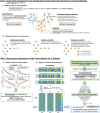Brain structural covariance networks in obsessive-compulsive disorder: a graph analysis from the ENIGMA Consortium
- PMID: 32040561
- PMCID: PMC7009583
- DOI: 10.1093/brain/awaa001
Brain structural covariance networks in obsessive-compulsive disorder: a graph analysis from the ENIGMA Consortium
Erratum in
-
Corrigendum.Brain. 2020 May 1;143(5):e44. doi: 10.1093/brain/awaa061. Brain. 2020. PMID: 32163544 Free PMC article. No abstract available.
Abstract
Brain structural covariance networks reflect covariation in morphology of different brain areas and are thought to reflect common trajectories in brain development and maturation. Large-scale investigation of structural covariance networks in obsessive-compulsive disorder (OCD) may provide clues to the pathophysiology of this neurodevelopmental disorder. Using T1-weighted MRI scans acquired from 1616 individuals with OCD and 1463 healthy controls across 37 datasets participating in the ENIGMA-OCD Working Group, we calculated intra-individual brain structural covariance networks (using the bilaterally-averaged values of 33 cortical surface areas, 33 cortical thickness values, and six subcortical volumes), in which edge weights were proportional to the similarity between two brain morphological features in terms of deviation from healthy controls (i.e. z-score transformed). Global networks were characterized using measures of network segregation (clustering and modularity), network integration (global efficiency), and their balance (small-worldness), and their community membership was assessed. Hub profiling of regional networks was undertaken using measures of betweenness, closeness, and eigenvector centrality. Individually calculated network measures were integrated across the 37 datasets using a meta-analytical approach. These network measures were summated across the network density range of K = 0.10-0.25 per participant, and were integrated across the 37 datasets using a meta-analytical approach. Compared with healthy controls, at a global level, the structural covariance networks of OCD showed lower clustering (P < 0.0001), lower modularity (P < 0.0001), and lower small-worldness (P = 0.017). Detection of community membership emphasized lower network segregation in OCD compared to healthy controls. At the regional level, there were lower (rank-transformed) centrality values in OCD for volume of caudate nucleus and thalamus, and surface area of paracentral cortex, indicative of altered distribution of brain hubs. Centrality of cingulate and orbito-frontal as well as other brain areas was associated with OCD illness duration, suggesting greater involvement of these brain areas with illness chronicity. In summary, the findings of this study, the largest brain structural covariance study of OCD to date, point to a less segregated organization of structural covariance networks in OCD, and reorganization of brain hubs. The segregation findings suggest a possible signature of altered brain morphometry in OCD, while the hub findings point to OCD-related alterations in trajectories of brain development and maturation, particularly in cingulate and orbitofrontal regions.
Keywords: brain structural covariance network; graph theory; illness duration; obsessive-compulsive disorder; pharmacotherapy.
© The Author(s) (2020). Published by Oxford University Press on behalf of the Guarantors of Brain.
Figures





References
-
- Amlien IK, Fjell AM, Tamnes CK, Grydeland H, Krogsrud SK, Chaplin TA, et al.Organizing principles of human cortical development–thickness and area from 4 to 30 years: insights from comparative primate neuroanatomy. Cereb Cortex 2016; 26: 257–67. - PubMed
Publication types
MeSH terms
Grants and funding
LinkOut - more resources
Full Text Sources
Medical
Miscellaneous

